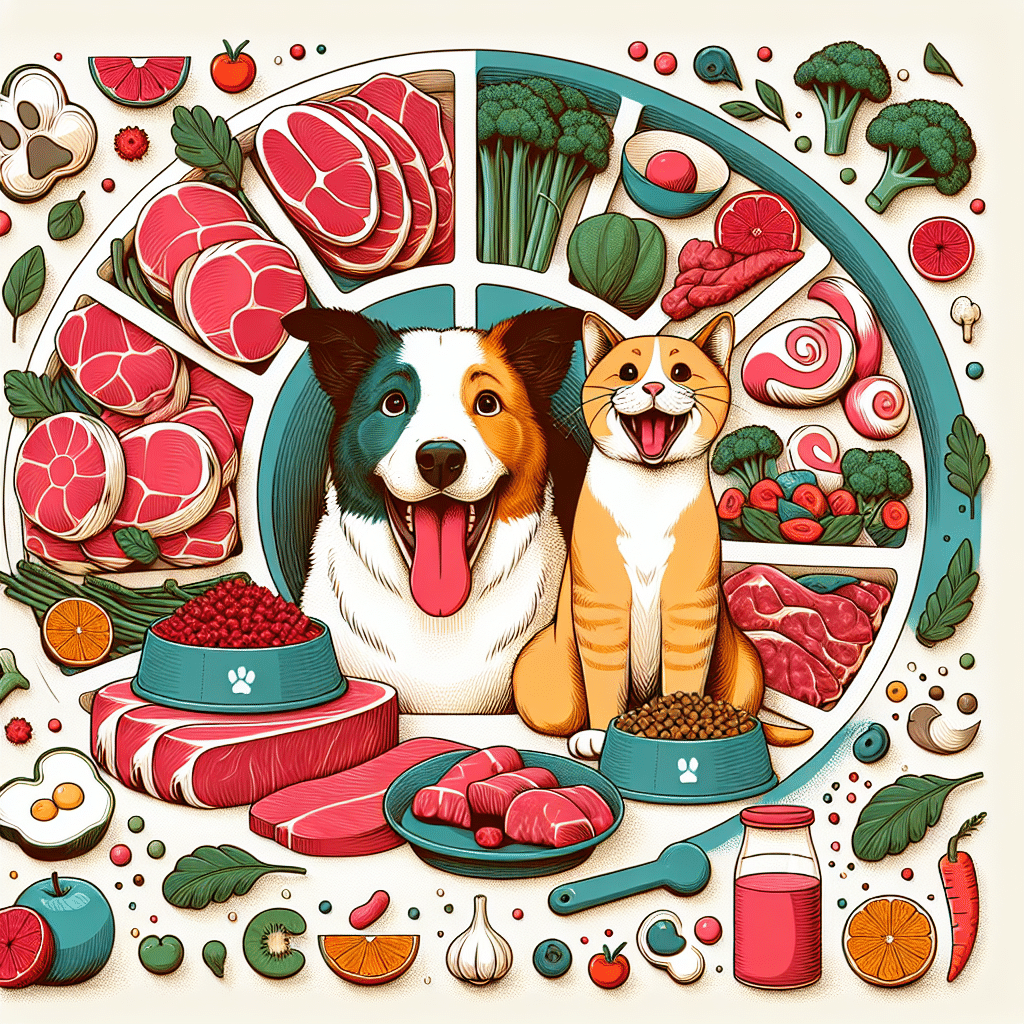Understanding Raw Food Diets for Pets
Creating a balanced raw food diet for your pets involves understanding their nutritional needs, individual health requirements, and the sources of high-quality ingredients. This guide offers detailed insights into crafting a balanced raw food diet for dogs and cats.
Nutritional Needs of Pets
Macronutrients
- Proteins: Essential for growth, maintenance, and repair of tissue. Dogs typically require about 18-25% of their daily caloric intake from proteins, while cats need around 30-40%.
- Fats: Important for energy and efficient absorption of fat-soluble vitamins. Aim for 5-15% of the diet for dogs and 20-40% for cats.
- Carbohydrates: These provide energy but should not be the primary focus. Cats, being obligate carnivores, require minimal carbohydrates, while dogs can digest more due to their omnivorous nature.
Micronutrients
- Vitamins and Minerals: Activate enzymes and play key roles in cellular reactions. Essential vitamins include A, E, D, B-complex, and minerals such as calcium, phosphorus, and potassium.
- Water: Though not a nutrient, water is vital for hydration and overall health. Ensure that your pet always has access to fresh water, irrespective of their diet choices.
Components of a Balanced Raw Food Diet
Protein Sources
- Muscle Meat: Include beef, chicken, turkey, and lamb. Select lean cuts for dogs and ensure that cats have access to a variety of muscle meats.
- Organs: Liver, kidney, and pancreas provide essential vitamins and minerals. Typically, organs should make up about 10-15% of the total diet.
- Bones: Feed raw meaty bones to promote dental health and provide calcium. Avoid cooked bones, which can splinter.
Vegetables and Fruits
- Incorporate non-starchy vegetables like spinach, carrots, and broccoli to provide fiber and vitamins. Cats require minimal vegetable matter, making it beneficial to include only in small amounts.
- Fruits, such as blueberries, apples (without seeds), and bananas, can serve as treats—but should be limited in quantity due to their sugar content.
Supplements
- Fish Oil: Rich in Omega-3 fatty acids, beneficial for skin and coat health.
- Calcium Supplementation: If bones are not a regular part of the diet, consider using ground eggshells or specific calcium supplements.
- Probiotics: Support digestive health; consider adding fermented foods or specific probiotic supplements designed for pets.
Sample Raw Food Diet Recipes for Pets
Dog Recipe Example
-
Ingredients:
- 1 pound of ground beef
- 4 ounces of liver (beef or chicken)
- 1 cup of chopped carrots
- 1 cup of spinach
- ¼ cup of blueberries
- 1 teaspoon of fish oil
-
Preparation:
- Mix the ground beef and liver together in a bowl.
- Chop or grind the vegetables and fruits.
- Combine everything and add fish oil for additional nutrients.
- Store in airtight containers, refrigerate, or freeze in portions.
Cat Recipe Example
-
Ingredients:
- 1 pound of chicken thighs (with bones)
- 2 ounces of chicken liver
- ½ cup of chopped spinach
- 1 tablespoon of fish oil
-
Preparation:
- Whirl the chicken and liver in a food processor until a chunky paste forms.
- Add finely chopped spinach and fish oil, mixing well.
- Serve fresh or store in individual portions.
Adjusting Diet for Life Stages and Health Conditions
Puppies and Kittens
- Young, growing pets require higher protein and fat levels to support growth. Ensure the diet includes more organ meats and a variety of muscle meats.
Adult Pets
- Focus on maintaining an ideal weight. Adjust portion sizes and monitor body condition regularly.
Senior Pets
- Senior pets might require lower-calorie diets. Focus on high-quality proteins, supplemented with joint-supporting nutrients like glucosamine and omega-3.
Health Conditions
- Pets with specific health issues, such as pancreatitis or kidney disease, may need customized diets. Always consult with a veterinarian before making dietary changes.
Implementing the Raw Food Diet
Transitioning Your Pet
- Gradually introduce raw food into your pet’s diet over 7-10 days. Start with small amounts mixed with their current food, gradually increasing the raw portion.
- Monitor for any adverse reactions or digestion issues and adjust as necessary.
Safety and Hygiene
- Always handle raw meats with care to avoid cross-contamination. Use separate cutting boards and utensils for raw and cooked foods.
- Thoroughly wash hands and surfaces after preparing raw foods.
Storing and Handling Raw Food
- Store raw food in airtight containers and refrigerate or freeze to maintain freshness. Be aware of shelf life—raw meat can typically last 1-2 days in the fridge and several months in the freezer.
- Thaw frozen food in the refrigerator, never at room temperature, to prevent bacterial growth.
Common Misconceptions About Raw Food Diets
-
Myth: Raw diets are unsafe.
- Fact: With proper sourcing and handling, raw diets can be safe and effective. Awareness of potential risks and appropriate hygiene practices can mitigate these concerns.
-
Myth: Dogs can survive on meat alone.
- Fact: Both dogs and cats require a broader range of nutrients. A well-rounded raw diet must include organ meats, bones, and even some fruits and vegetables for dogs.
Conclusion: Importance of Research and Consultation
Creating a balanced raw food diet for your pets involves careful consideration of their individual needs and a comprehensive understanding of nutritional principles. Before implementing significant dietary changes, consulting with a veterinarian or a pet nutritionist can ensure a safe and effective transition to a raw food lifestyle. Always consider individual health factors, and monitor your pet’s condition regularly.
